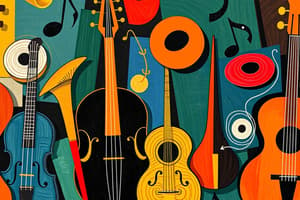Podcast
Questions and Answers
What is the primary purpose of classification in music?
What is the primary purpose of classification in music?
- To analyze the lyrics of a song
- To group music into various genres (correct)
- To identify the most popular songs
- To determine the tempo of a song
Which of the following machine learning algorithms is used in music classification?
Which of the following machine learning algorithms is used in music classification?
- Gradient Boosting
- Random Forest
- Naive Bayes
- Support Vector Machines (SVM) (correct)
What is the main challenge in music classification?
What is the main challenge in music classification?
- The ambiguity and subjectivity of music (correct)
- Collecting a large dataset of music
- Selecting the most appropriate machine learning algorithm
- Developing more complex machine learning models
What is the goal of future work in music classification?
What is the goal of future work in music classification?
What is used to measure the distance between music pieces in classification?
What is used to measure the distance between music pieces in classification?
What is the primary goal of music classification in music information retrieval?
What is the primary goal of music classification in music information retrieval?
What is the main challenge in automatic genre classification?
What is the main challenge in automatic genre classification?
What is the purpose of genres in music information retrieval?
What is the purpose of genres in music information retrieval?
What technique is used to achieve high accuracy on private datasets in genre classification?
What technique is used to achieve high accuracy on private datasets in genre classification?
What are the two main steps involved in automatic music genre classification?
What are the two main steps involved in automatic music genre classification?
What type of features are extracted from the audio or symbolic representation of music in feature extraction?
What type of features are extracted from the audio or symbolic representation of music in feature extraction?
Flashcards are hidden until you start studying
Study Notes
Music Classification
Music classification is an essential aspect of music information retrieval (MIR) and refers to the process of categorizing music based on various criteria, such as genre, mood, tempo, and other musical characteristics. It is a complex task due to the subjective nature of music and the large amount of data available.
Genre Classification
Genre classification is one of the sub-disciplines of MIR that is gaining popularity among researchers. Genres are useful for organizing music, creating personalized listening experiences, and generating playlists. However, the ambiguity and subjectivity of music make automatic genre classification challenging.
One approach to genre classification is using transfer learning techniques, such as audio-based categorization, which can achieve high accuracy on private datasets. Another method is using deep learning models, such as convolutional neural networks (CNN) and long short-term memory (LSTM) network, which can learn representations of time series data while accounting for temporal dynamics.
Feature Extraction and Classification
Automatic music genre classification involves two main steps: feature extraction and classification. Feature extraction involves extracting relevant information from the audio or symbolic representation of the music, such as non-negative matrix factorization (NMF) features, Short-Time Fourier Transform (STFT) features, and pitch features. Classification involves using machine learning algorithms, such as support vector machines (SVM), k-nearest neighbor (KNN), or deep learning models, to classify the music into various genres.
Music Representation and Distance Measures
Various music representations and distance measures have been used in music classification research. For example, Goienetxea et al. proposed an approach to classify music pieces by grouping close related known pieces into different sets or clusters and using the same distance to separate the clusters.
Challenges and Future Work
Despite the advances in music classification, several challenges remain, such as the ambiguity and subjectivity of music, the need for effective feature extraction, and the selection of appropriate machine learning algorithms for specific tasks. Future work in music classification may focus on addressing these challenges and developing more accurate and effective music classification systems.
Studying That Suits You
Use AI to generate personalized quizzes and flashcards to suit your learning preferences.




